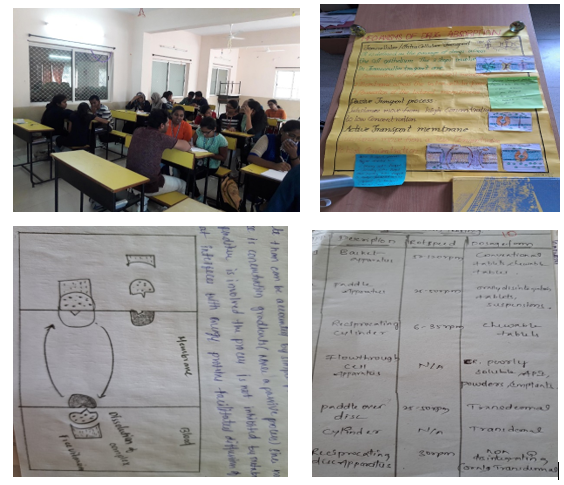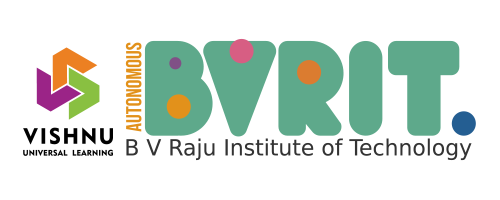Small Group Activity and Chart Presentations:
Subject: Biopharmaceutics and pharmacokinetics
Topic: Classify the routes of drug administration along with mechanism and factors influencing absorption.
Activity description:
- In this activity, students are assigned specific roles within their groups: one as writer, another as reader, and third as the monitor, to ensure active participation.
- Each group is provided with a topic related to mechanisms of drug absorption & given 30 min to construct a model chart that represent their understanding.
- Followed by chart creation, each group presents their findings within 3 min presentation. Subsequently, students are allotted 15 min to individually create a mind map based on the presented topics.
Outcome:
This activity enhanced understanding of drug absorption mechanisms through collaborative model chart creation and concise presentations. Improved retention of knowledge and individual assessment through personalized mind mapping evaluation.

Subject: Material and energy balance computations
Topic: Perform basic process calculations involving unit conversion, physical quantities evaluation, Ideal gas law and Raoults law
Activity description:
- Choose a chemical/biochemical reaction, with the products of commercial /industrial importance.
- Explain the reaction mechanism in the form of story, represent pictorially the story on chart and Balance the reaction.
- Find the quantity of reactant/reactants (parts by weight) required to form 100 parts by weight of any one the desired product.
Outcome:
- Evaluate amount of product formed based on mass relations and balanced Stoichiometric equation and explanation of reaction mechanism in the form of story enhances creativity.
Role Play and Class Quiz activity:
Subject: Biopharmaceutics and pharmacokinetics, Physical Pharmacy
Topic: Illustrate the various phases of drug metabolism, enzymatic action on the drug metabolism, and mechanism of action of surfactants
- Students were grouped in to two teams, designated as ‘A’ and ‘B’. Team ‘A’ demonstrated the enzyme induction (15 min) while team ‘B’ showcased enzyme inhibition (15 min).
- After the group activity 10 min time is given to each team to prepare a set of questions and quiz was conducted between two teams. Each team will pose a question for other team regarding their respective topics, with 1min allotted for each response. A designated reader from each team presents their answer after team discussion. Marks were assigned based on the quality of the response.
Outcome:
As the student immersed themselves in scenarios and could be able to differentiate enzyme induction and inhibition after roleplay. Class quiz encouraged them to recall the information and to identify the areas where they need further clarification on the topic.
Model Making (Group activity):
Subject: Fluid Mechanics and Mechanical Unit Operations
Topic: Rheological properties of fluids -classification of fluids
The aim of the group activity is
- Engaging all the students in the class
- Ability to break complex tasks into parts
- Plan and manage time.
- Refine understanding through discussion and explanation
Outcomes:
Students are able to Co-ordinate among themselves and sharing their ideas on the topic in many ways from different views. Also, able to identify which type of fluids are come under which type of fluid like Newtonian and Non-Newtonian. Capability of understanding improved through practical applications.
Industrial visit:
Subject: Fluid Mechanics and Mechanical Unit Operations
Topic: Mechanical unit operations – orifice meters , filters ,spray chambers etc
- The main objective of industrial tour was to bridge the gap between classroom teaching and practical working environment.
- Provide students with a chance to meet industry leaders, professionals for sharing their knowledge and experience.
Outcome:
Students are visited to Ganapathi Sugar industry to observe various Mechanical unit operations involved and equipment’s like Orifice meters, rotary drum filters, reactors, spray chambers etc. This event was conducted on between the semester, as a practical implication to what they have learnt as a result of which solutions to the practical world problems were identified and were tried to solve in stipulated time. An report on Industrial visit is asked to submit by the students.
Quizlet Flash Cards Activity:
Subject: Physical Pharmacy
Topic: Important Terminology
- Presented flashcards to make them understand terminology in physical pharmacy. That were projected in the classroom gave 2 min time to memorize with suitable illustration and write in the classwork.
Outcome: Student can able to remember definitions.
Think Pair Share Activity:
Subject: Material and energy balance computations
Topic: Material balance without reaction -Difficulty in construction of block diagram with input and output, basis and evaluation of unknown quantities
Activity description:
The purpose: Perform material balance computations
Discussion guidelines: The students need to find the missing quantities in the process flow sheet of the given numerical question using the step-by-step procedure for material balance, as per the allotted time with their partner.
- Step 1: Think, time allotted 5 minutes.
- Step 2: Pair, Time allotted: 10 minutes. Students get into pairs as decided by faculty considering student attendance and active behaviour in class. The students to share what they came up with, with their partners and discuss.
- Step 3: Share, Time allotted: 10 minutes. Students come together as a class and have a whole class discussion on the approach they followed to do the material balance.
Outcome: Helps with collaboration and presentation skills. Students who are typically shy may feel more comfortable sharing with the class after sharing with a partner.
Pharmacology Mnemonics
Subject: Pharmacology
Topic: Drugs Classification with Mnemonics
Activity description:
- The purpose of this activity is to familiarize students with pharmacology drugs through the creation and application of mnemonic, enhancing their memory retention and recall skills.
- Instructed each student to brainstorm and create mnemonic for remembering the drug names .
- Encouraged the students to prepare mnemonics association with visual aids .
Outcome:
This activity Successfully recalling pharmacology drugs names can boost students’ confidence in their ability to learn and retain knowledge.
Improved retention of knowledge and individual assessment done through minute paper activity.










